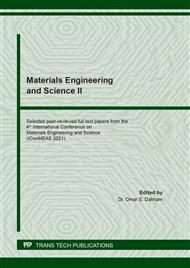[1]
X. Ouyang, X. Jiang, X. Qiu, D. Yang, Y. Pang, Effect of molecular weight of sulfanilic acid-phenol-formaldehyde condensate on the properties of cementitious system, Cement and concrete research. 39 (2009) 283–288.
DOI: 10.1016/j.cemconres.2009.01.002
Google Scholar
[2]
A. M. Díez-Pascual, Synthesis and applications of biopolymer composites, Int. J. Mol. Sci. 20 (2019) 2321-2328.
Google Scholar
[3]
S. C. Alcázar-Alay and M. A. Meireles, Physicochemical properties, modifications and applications of starches from different botanical sources, Food Science and Technology. 35 (2015) 215-236.
DOI: 10.1590/1678-457x.6749
Google Scholar
[4]
B. Wei, C. Cai, Y. Tian, Nano-sized Starch: Preparations and Applications, in, Z. Jin, Functional Starch and Applications in Food, Springer Publishing., Singapore, 2018, pp.147-149.
DOI: 10.1007/978-981-13-1077-5_6
Google Scholar
[5]
G. R. Otoko, Minimising hot weather effects on fresh and hardened concrete by use of cassava powder as admixture,, Eur. Int. J. Sci. Technol., vol. 3, no. 2, p.1–8, (2014).
Google Scholar
[6]
A. A. Akindahunsi and H. C. Uzoegbo, Strength and durability properties of concrete with starch admixture,, Int. J. Concr. Struct. Mater., vol. 9, no. 3, p.323–335, (2015).
DOI: 10.1007/s40069-015-0103-x
Google Scholar
[7]
N. K. Amudhavalli, J. Mathew, Effect of silica fume on strength and durability parameters of concrete, International journal of engineering sciences & emerging technologies. 3 (2012) 28-35.
Google Scholar
[8]
Iraqi Standard Specification. No.5. Portland Cement. Central Agency for Standardization and Quality Control. Baghdad, Iraq. (1984).
Google Scholar
[9]
Iraqi Standard Specification, No.45. Natural Aggregate Resources used in Concrete and Construction. Central Agency for Standardization and Quality Control. Baghdad, Iraq. (1984).
Google Scholar
[10]
ASTM C1240. Standard Specification for Silica Fume Used in Cementations Mixtures. West Conshohocken, USA. (2010).
Google Scholar
[11]
ASTM C494. Standard specification for Chemical Admixtures for Concrete. ASTM International. West Conshohocken, USA. (2004).
Google Scholar
[12]
ASTM C143. Standard test method for slump of hydraulic cement concrete. ASTM International. West Conshohocken, USA. (2000).
Google Scholar
[13]
ASTM 138M. Standard test method for fresh density of concrete. ASTM International. West Conshohocken, USA. (2001).
Google Scholar
[14]
B.S. 1881, Part 116. Method for determination of compressive strength of concrete cubes. British Standards Institution, England. (1989).
Google Scholar
[15]
ASTM C496. Standard test methods for splitting tensile strength of cylindrical. ASTM International. West Conshohocken, USA. (2004).
Google Scholar
[16]
ASTM C78. Standard test methods for flexural strength of concrete. ASTM International. West Conshohocken, USA. (2004).
Google Scholar
[17]
ASTM C597. Standard test Method for Pulse Velocity Through Concrete. ASTM International, West Conshohocken, USA. (2002).
Google Scholar
[18]
F. K. Abdulhussein, Z. F. Jawad, and Q. J. Frayah, Investigation of the Effect of Addition Nano-papyrus Cane on the Mechanical Properties of Concrete, Civ. Eng. J. 7 (2021) 226–235.
DOI: 10.28991/cej-2021-03091649
Google Scholar
[19]
W. A. Abbas and H. M. Mohsen, Properties and Behavior of Starch Biopolymer Concrete, Eng. Technol. J, 38 (2020) 1414–1420.
DOI: 10.30684/etj.v38i10a.365
Google Scholar
[20]
U. T. Bezerra, Composites Portland-biopolymer for well cementing, Ph.D. thesis, UFRN University, (2006).
Google Scholar
[21]
M. K. Hossain, M. A. Rashid, and M. R. Karim, Effect of cement content and size of coarse aggregate on the strength of brick aggregate concrete, DUET J. 2 (2015) 20–24.
Google Scholar
[22]
M. Rosseto et al., Accelerated Aging of Starch-Gelatin Films with Enzymatic Treatment, J. Polym. Environ, 29 (2021) 1063–1075.
Google Scholar
[23]
G. A. Salman, Density and ultrasonic pulse velocity investigation of self-compacting carbon fiber-reinforced concrete, Engineering and Technology Journal, 36 (2018) 89-99.
DOI: 10.30684/etj.2018.136783
Google Scholar


